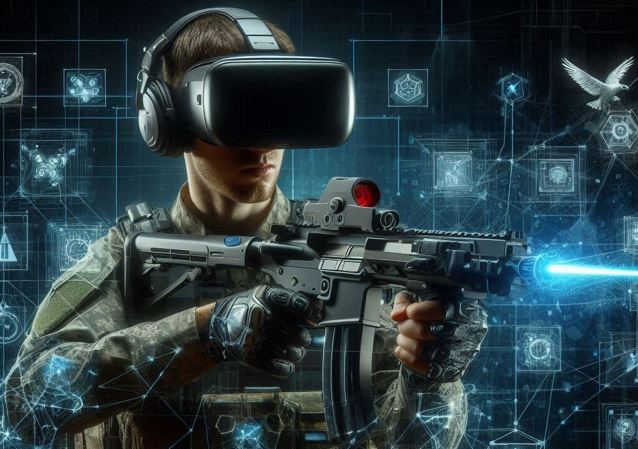Adaptive AI systems: The VR Combat Mechanics
Virtual reality gaming has gone through the roof within recent years, and users are looking for more encompassing and challenging experiences that are specifically away from normal practices of gaming. The greatest use of VR can be seen in its ability to create realistic, thrilling combat scenarios. Adaptive AI systems change the kind of virtual battles that these systems have brought in; with them, the encounters become dynamic, intelligent, and deeply engaging. Advanced system players can be analyzed, strategies may be altered, and responses are provided in real-time so that no two battles are quite the same. This is where the battle of VR combat mechanics is stepped up and changed at a gamer’s play level: harder, rewarding, and responding to a unique player’s approach.
Adaptive AI’s role in VR combat
Traditional NPCs in games are mostly hardcoded and deterministic, consistent with predictable patterns. Contrary to this, adaptive AI systems learn and adapt based on how a player goes about playing the game. Thus, battles in VR are going to be all the more realistic and responsive with changes in the strategies of enemy AI reacting to mistakes and exploiting weaknesses by some intelligent logic other than coding.
The technologies used in developing AI support the combat scenarios of VR as unpredictable as a real thing would be. An example is an adaptive enemy that will notice when a player tends to rely on a certain weapon and will create counter-measures aimed at neutralizing said advantage. It encourages players to think on their feet and adjusts strategy-hence, increased engagement and replayability.
Adaptive AI systems make use of data-driven algorithms which automatically adapt according to the pattern of the player’s actions. Each player’s move, tactic, or decision would change the behavior of the AI; hence, there is a unique combat experience every time. The result of machine learning techniques indicates analysis of patterns and suitable adaptation of strategies.
For example, if a character who is playing relies heavily on ranged attacks, adaptive AI could reinforce with shield-wielding units or close ranks rapidly to force a melee battle. On the other hand, if the player takes stealth, adaptive AI could respond by seeding patrols, deploying traps or contacting allied NPCs to alert them to sneak attacks. The capability to learn makes VR combat so much more immersive and adds complexity that was impossible to achieve in traditional game development.
Real-Time Adaptation and Strategy Switchover
Adaptive AI is surely one of the most impressive areas of adaptive intelligence-it can change behavior in real time. This is relatively different from the static AI type, as it presupposes a set of patterns to be followed. Adaptive AI, on the other hand, can immediately react to a change in situational conditions on the battlefield. This plays an especially significant role in the development of VR games, wherein immersion is especially important.
When the player suddenly changes his strategy during a VR battle and turns cautiously from an aggressive offense into prudent defense, the AI counterpart will embrace the change and pressure him into retreating or lead him into a trap. Such responsiveness really makes for an electrifying game atmosphere in which players are always measuring up and responding; it means encounters never become stale or repetitive.
Personalized Combat Scenarios
Adaptive AI provides the possibility of creating customized experiences: analyzing the level, playstyle of a player, and the behavior demonstrated during gameplay, the AI will be in a position to tailor combat scenarios to the class of their skills. For novices and veterans alike, this ensures satisfaction from being challenged.
The adaptive AI can increase its level of difficulty progressively as the players improve. Early fights in a VR fighting game may easily engage them with the non-complex behaviour of the enemy but may introduce sophisticated combos, feints, and counters, challenging the best capabilities of the players as they improve. That personalization is what helps keep the interest of the players as it may avoid boredom but also prevent frustrating spikes in difficulty.
Contextual Decision-Making
Adaptive AI systems also understand contextual decision making, wherein an NPC considers environmental constraints, resources that it has at its disposal, and player choices before deciding its next course of action. It is due to this reason that combat feels more organic and responsive. For example, if a player traps an enemy in a narrow corridor, adaptive AI may use the constraint to its advantage by securing ambush points above or flanking hidden routes.
The infusion of contextual decision-making into the designing of combat mechanics within VR gives the players the feeling that they are actually fighting the intelligent and self-aware opponents. Besides that, this seems to increase the believability of the game world and makes the stakes much higher, leading to memorable moments people would relish repeating and sharing with others.
Competitive Combat Behaviors
Making VR combat realistic would require NPCs to behave more like human-beings. They should act in ways that include showing fear, hesitation, aggression and even forming alliances according to the scenario. Adaptive AI systems can portray those characteristics thus enabling them to compute risks, retreat, regroup, and coordinate with other units.
In big battles with VR, adaptive AI could control scores of NPCs in the execution of sophisticated strategies. For instance, a concerned enemy commander can tell the pincer attack or command suppressive fire that holds up the player or orders scouts to scout weak points. In mirroring the real world tactics, adaptive AI can create an immersive yet realistic battle scenario that challenges the strategic minds of the players.
AI-Powered Armaments and Tactics
Adaptive AI can also change the level of weaponry and tactics it uses in response to play. For example, if a player leans on melee attacks, the AI can introduce enemies equipped with long-range weapons or set traps close to impossible to avoid at close range. Then, if the player keeps moving behind cover, AI-based units will begin to shell the area with explosives to flush him out.
The approach never forces a player to do the same things repeatedly while still making combat fresh and unpredictable, but each encounter also feels unique because of the AI reacting uniquely to player strategy.
This kind of versatility is invaluable in the development of AAA VR games, with players expecting innovations in the latest gameplay mechanisms that are on the edges of what could be achieved.
In the case that adaptive AI produces a fascinating combat scenario, the situation calls for challenge balancing with fairness: A player needs to understand he or she has a real chance to win without hopelessly being on the losing end. This requires careful fine-tuning of AI behavior to balance challenges while avoiding impossible battles with NPCs.
Player feedback and data analytics are used by developers to tweak the adaptive AI systems to make sure that areas are spotted where the difficulty level is too high or too low. Improving these systems continuously will help VR gaming studios provide a more balanced experience with respect to combat, catering to a broad spectrum of players. This requires a technical understanding as well as an understanding of the psychology of the player because the difference between engagement and frustration will make or break the game.
Leverage AI for Great Storytelling
Adaptive AI can also develop storytelling in the VR game. It would be possible to develop narratives that change based on the actions of a player if adaptive AI also empowers NPCs to remember previous encounters and interactions. Then, an enemy, who barely escaped defeat, vows revenge and becomes some kind of a recurring enemy to pursue. Similarly, the ally, who witnessed bravery, promises to help the player in the following battles.
These narrative-related conflicts add a relevance to the game world and bring about emotional attachment by players to characters, which then makes victories meaningful and defeats profound. This is, especially for computer games development in the realm of Virtual Reality where immersion and emotional attachment are what make an experience remembered.
AI and Procedural Content Generation
Another interesting application of adaptive AI in VR combat is procedural content generation. The power of AI-driven algorithms capable of producing enemies, weapons, and combat scenarios means that developers can now offer an infinite variety of experiences. Every play-through may feel unique, with challenges, rewards, and encounters being tailored to the level of progress of the player.
This method is particularly appealing to players who enjoy replayability along with exploration. Procedural generation of dungeons, arenas and missions by VR gaming studios can ensure the content is interesting enough at all times for a player whose skill level changes. Together, adaptive AI and procedural generation offer unparalleled scalability and depth, which is why they are highly useful for developers looking to craft vast VR worlds.
The Future of Adaptive AI in VR Combat
To extreme opinion, the future of adaptive AI in VR combat mechanics is terrific. It means that during the coming years, their NPCs will become much more complicated, with behavior and depth as if it were to blur the lines between reality and virtuality. In this way, combat experiences that developers would craft would be as complex, challenging, and rewarding as the real world itself.
Through the coming years we can see AI systems that learn from both the individual interaction of players but also from the collective behavior of players. This will in turn enable NPCs to learn and adapt to new emerging meta-strategies so combat doesn’t get stale and remains as fresh and challenging for veteran players as it does for the newcomer. With AI in VR gaming, studios can deliver experiences that push the boundaries of gaming and redefine what is possible in virtual reality.
Ethical Issues and Player Experience
Adaptive AI systems bring together many benefits, but they also have several issues that go beyond ethics. Game developers should ensure the NPCs do not cross the line of being manipulative so much that the challenges become frustrating and impossible to overcome. This is a tightrope to walk between difficulty, engagement, and accessibility to provide the ideal player experience.
This will thus allow developers to sharpen adaptive AI systems to perfectly deliver fair and engaging combat encounters for players. They will still be accessible to a wide audience with depth and complexity that experienced players crave in an attempt to maintain the accessibility of VR combat mechanics for a wider audience.
Adaptive AI systems are fundamentally, positively changing VR combat mechanics by creating intelligent, responsive and lifelike NPCs that challenge players in unprecedented ways. These systems enhance the level of immersion of players in VR games through real-time adaptation, personalized encounters, and complex combat strategies. For VR gaming development studios and developers, unlocking the power of adaptive AI unlocks new possibilities that will transcend current limitations of combat mechanics and deliver memorable, impactful gameplay experiences that captivate players around the world. Technology only gets better, so the future of adaptive AI in VR combat is very promising, turning virtual battles into quite thrilling adventures.



